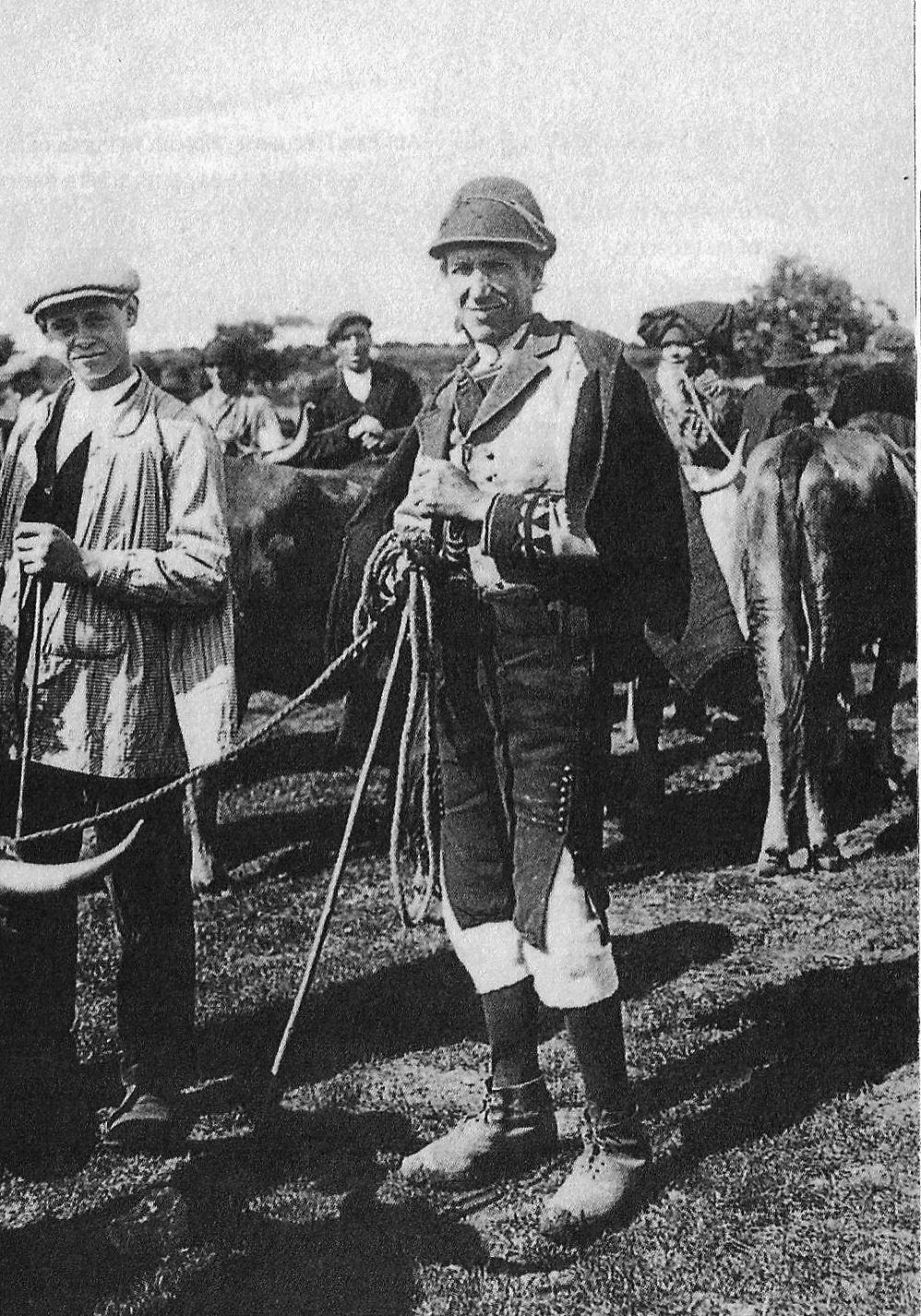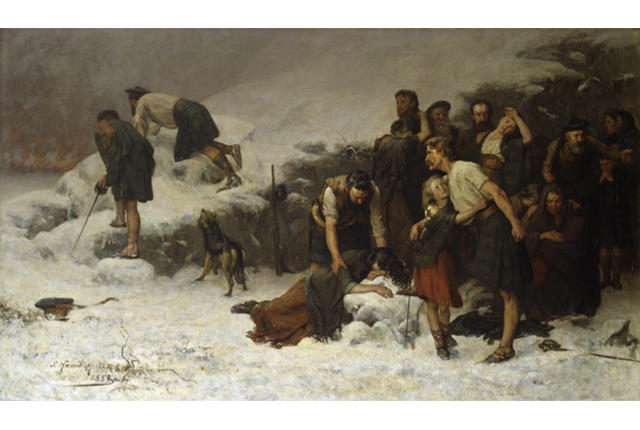Tratantes
Tratante, chámase así ao feirante comprador de gando vacún na feira ou polas portas. Esta tarefa está asociada aos homes aínda que no coidado e mantenza do gando traballan tanto homes coma mulleres.
Os tratantes chegan ás feiras da zona ataviados co seu mandilón de cor negra para se diferenciar dos demais aínda que esta vestimenta é cada menos frecuente. Mercan as vacas para carne ou para cría (vaqueiros) e/ou becerros (becerreiros) para as carnizarías e para recría. Tamén visitan a pé, a cabalo ou en coche as casas dos paisanos para lles mercar os xatos ou becerros e, se tiñan que facer noite, tradicionalmente paraban nas tabernas das aldeas.
Cando saen a mercar gando polas casas acostuman a levar moitos cartos nos petos para lles facer os pagamentos dos becerros aos paisanos, xa que sempre hai preferencia por cobrar ao contado.
Nas feiras estes tratantes de gando vacún delimitan as reses que pretenden mercar. Depois empezan observando polo miúdo a cabeza do gando que lles interesa, sen que o dono se dea por aludido da espionaxe. A revisión do animal continúa, examinándolle a anatomía apalpándolle certas partes, observando a dentamia e de seguido entran no "trato" co dono do animal. O proceso do trato empeza co axuste do prezo, ofrecéndolle un prezo mínimo baseándose nalgún defecto, máis ficticio que real, que lle atribúe ao animal. A indignación do vendedor non se fai esperar e durante a fase do "trato" co dono do animal ambos os dous discuten, xesticulan e xuran aparentemente enfadados. Agora é o momento da intervención dos "brancos" ou "medianeiros", amigos dun e doutro, que afianzan as respectivas posturas. Logo de moitas negociacións chegan ao acordo e o mercador compra o animal marcándoo cun sinal que fai cunhas tesoiras sen danar ao animal. Con isto o "trato" pechouse e o gandeiro entrégalle ao tratante a res pero non a corda, por que existe a crenza de que con ela vai a sorte da casa.
Dealers
Tratante is the name for bovine cattle buyers that purchase these animals at fairs and also house by house. This task was performed by men, although looking after and feeding the cattle was done both by men and women.
Dealers arrived at the fairs in the area wearing their black aprons to differentiale theselves from everyone else: however, this piece of clothing is becoming less common. They bought cows both for meat and for breeding (vaqueiros) and/or calves (becerreiros) for butcher shops and for breeding. They also visited on foot, by horse or by car the houses of the villages to buy xatos or calves and if they had to spend the night away, they would usually sleep at an inn in the village.
When they went out to buy cattle around the houses they usually carried lots of money to pay the calves to the villagers, as these preferred cash.
At the fairs, these cow dealers identified the animals that they intended to buy. Then they checked in detail the head of those they were interested in, while the owner pretended not to notice the examination. The inspection of the animal continued by checking its body, feeling certain parts, and checking its teeth to then start dealing with the owner. The process (trato) started by haggling about the price, with the dealer offering a minimun price based on some defect, more fictitious than real that he had found in the animal. The outrage of the seller would not take long to appear and during the haggling both of them argued, gesticulated and swore, apparently angry. It was at this point is when the branos or medianeiros, friends of each party, intervenned in order to establish their positions. After several negotiations, they reached an agreement and the dealer would buy the animal and mark it using a pair of scissors without hurting the animal. In doing so, the deal was closed and the farmer handed over the animal but not the rope, as there was the belief that giving this away luck would leave the household.
Técnicas artesanais tradicionais
Traditional craft techniques
José Antonio Fidalgo Santamariña e Fátima Braña Rey
Tratante, chámase así ao feirante comprador de gando vacún na feira ou polas portas. Esta tarefa está asociada aos homes aínda que no coidado e mantenza do gando traballan tanto homes coma mulleres.
Os tratantes chegan ás feiras da zona ataviados co seu mandilón de cor negra para se diferenciar dos demais aínda que esta vestimenta é cada menos frecuente. Mercan as vacas para carne ou para cría (vaqueiros) e/ou becerros (becerreiros) para as carnizarías e para recría. Tamén visitan a pé, a cabalo ou en coche as casas dos paisanos para lles mercar os xatos ou becerros e, se tiñan que facer noite, tradicionalmente paraban nas tabernas das aldeas.
Cando saen a mercar gando polas casas acostuman a levar moitos cartos nos petos para lles facer os pagamentos dos becerros aos paisanos, xa que sempre hai preferencia por cobrar ao contado.
Nas feiras estes tratantes de gando vacún delimitan as reses que pretenden mercar. Depois empezan observando polo miúdo a cabeza do gando que lles interesa, sen que o dono se dea por aludido da espionaxe. A revisión do animal continúa, examinándolle a anatomía apalpándolle certas partes, observando a dentamia e de seguido entran no "trato" co dono do animal. O proceso do trato empeza co axuste do prezo, ofrecéndolle un prezo mínimo baseándose nalgún defecto, máis ficticio que real, que lle atribúe ao animal. A indignación do vendedor non se fai esperar e durante a fase do "trato" co dono do animal ambos os dous discuten, xesticulan e xuran aparentemente enfadados. Agora é o momento da intervención dos "brancos" ou "medianeiros", amigos dun e doutro, que afianzan as respectivas posturas. Logo de moitas negociacións chegan ao acordo e o mercador compra o animal marcándoo cun sinal que fai cunhas tesoiras sen danar ao animal. Con isto o "trato" pechouse e o gandeiro entrégalle ao tratante a res pero non a corda, por que existe a crenza de que con ela vai a sorte da casa.
Dealers
Tratante is the name for bovine cattle buyers that purchase these animals at fairs and also house by house. This task was performed by men, although looking after and feeding the cattle was done both by men and women.
Dealers arrived at the fairs in the area wearing their black aprons to differentiale theselves from everyone else: however, this piece of clothing is becoming less common. They bought cows both for meat and for breeding (vaqueiros) and/or calves (becerreiros) for butcher shops and for breeding. They also visited on foot, by horse or by car the houses of the villages to buy xatos or calves and if they had to spend the night away, they would usually sleep at an inn in the village.
When they went out to buy cattle around the houses they usually carried lots of money to pay the calves to the villagers, as these preferred cash.
At the fairs, these cow dealers identified the animals that they intended to buy. Then they checked in detail the head of those they were interested in, while the owner pretended not to notice the examination. The inspection of the animal continued by checking its body, feeling certain parts, and checking its teeth to then start dealing with the owner. The process (trato) started by haggling about the price, with the dealer offering a minimun price based on some defect, more fictitious than real that he had found in the animal. The outrage of the seller would not take long to appear and during the haggling both of them argued, gesticulated and swore, apparently angry. It was at this point is when the branos or medianeiros, friends of each party, intervenned in order to establish their positions. After several negotiations, they reached an agreement and the dealer would buy the animal and mark it using a pair of scissors without hurting the animal. In doing so, the deal was closed and the farmer handed over the animal but not the rope, as there was the belief that giving this away luck would leave the household.
Técnicas artesanais tradicionais
Traditional craft techniques
José Antonio Fidalgo Santamariña e Fátima Braña Rey






Comentarios